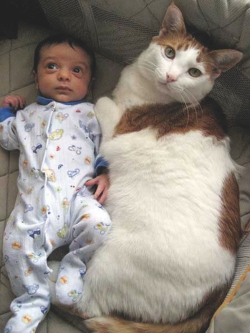| Home - Back Issues - The Team - Contact Us |
 |
| Volume 12 |Issue 04| January 25, 2013 | |
|
|
Health
Busting Myths Shanna Freeman and Christine Venzon They may have been useful at one time but the truths behind old wives' tales have gotten garbled in translation from one generation to the next. Accepting them gave people a sense of control over situations they couldn't control or didn't understand – and it still can today. This is especially true concerning the serious matters of health and illness, subjects that were more even mysterious to our ancestors than they are to us. In the following myth about health, we will try to ferret out the falsehoods, but also uncover any legitimate basis and modern research that make those old wives look like prophets. Just because we don't understand why our grandmothers (and grandfathers) did something, doesn't mean they didn't know what they were doing. Cats kill sleeping babies by stealing their breath Cats have been seen alternately as divine (the Egyptian goddess Bastet took a feline form) or evil (we all know black cats bring bad luck, right?). If the myth that cats steal sleeping babies' breath were true, it would definitely fit in with that darker image.
Cats' supposedly murderous ways have also been blamed on feline feelings of sibling rivalry: Kitty resents all the attention lavished on a new baby. It's true that cats can be disturbed by major disruptions to their lives, but they usually act out by urine marking – spraying or urinating outside the litter box – or becoming more vocal, not by plotting revenge. How did this myth start? It's possible that cats have inadvertently contributed to Sudden Infant Death Syndrome, or SIDS, in which an infant dies while sleeping for no known reason. Infants with respiratory conditions or an underdeveloped wake-response reflex are known to be at greater risk of SIDS. If such a child rolled toward a cat in his sleep, or if a cat stretched a paw on the baby's face, it might impair breathing enough to cause death. Then again, the cat's presence may have been pure coincidence. Cracking your knuckles causes arthritis The snap, crackle and pop of cracking knuckles really annoy some people. But is there a danger besides making a person unpopular among friends and co-workers? Let's compare the knuckle-cracking process to the condition of arthritis. Joints are surrounded by a lubricating, nourishing soup called synovial fluid. This fluid contains fats, nutrients to maintain bone health and dissolved gases. Cracking the knuckles stretches the capsule that surrounds the fluid, and stretching the capsule increases its volume, which lessens the pressure inside. The gases expand under this lower pressure, forming bubbles that eventually pop. Fortunately for knuckle-cracking haters, it takes a while for the gases to re-enter the solution, during which time the characteristic noises can't be made. Arthritis – specifically osteoarthritis – is the degeneration of cartilage, which is the spongy cushion between bones in a joint. The exact cause isn't known, but injury, repetitive motion, genetics and increased stress on the joints from excessive weight are contributing factors. In theory, straining or breaking a knuckle while cracking it might put you at risk for arthritis, but no study has ever linked cracking knuckles directly with the disease. Knuckles and other joints may also crack spontaneously due to natural changes in the ligament path over the bones. Cracking accompanied by pain, however, can signify other inflammatory conditions, including tendonitis and bursitis. You should starve a fever and feed a cold This old tale may be partly based on the medieval theory of humours. The idea was that good mental and physical health depended on the balance of four body fluids, called humours: black bile, yellow bile, blood and phlegm. A fever indicated an excess of blood, and the treatment included bleeding the patient – which, in retrospect, was not such good advice. Fasting may have also been prescribed as a way to slow down what seemed to be an overcharged metabolism. Likewise, every mucous mouthful a cold sufferer coughed up indicated an excess of phlegm. Phlegm was a wintry humour, associated with depressed spirits and depressed metabolism. The logical remedy was to stoke the bodily furnace with food, which would also lift the spirits. (This thinking may also underlie another myth: that you can "sweat out" a cold by bundling up, thus overheating the body.) When you're sick with a cold or the flu, your body needs the nutrients of a balanced diet and energy from adequate calories to fight off the infection, especially in the early stages of illness. There's no medical advantage to under-eating or over-eating in either case. Staying well nourished and well hydrated is the best advice. Eating sugar makes kids hyper Like some other myths on our list, this one has enough semblance of truth to sound legitimate. Simple sugars are pure calories (i.e., energy). They're quickly digested and sent to the bloodstream. So a rush of energy in the blood should cause a rush of activity in the body. The evidence often cited is the typical scenario of kids at a party. They binge on cake, cookies and sugary drinks, and then play games and generally wreak (mostly harmless) havoc. Ergo, sugar causes their behaviour. The science of sugar metabolism tells a different story, however. When sugars enter the bloodstream, they're first sent to the muscles and internal organs for immediate use. Excess sugars are not "worked off." They're stored in the liver and muscles as glycogen for later use. Anything over storage capacity winds up as fat. At the party, it's excitement that inspires the kids' rambunctiousness; sugar just fuels it. A bored child may snack on sweets or sugar-laden cereal and then watch TV or play video games quietly. Sugary snacks and sodas are rightly blamed for their role in obesity and tooth decay. But hyper behaviour is one rap you can't pin on them -- unless, of course, they're caffeinated products like cola or chocolate. Vitamin C cures the common cold This "old" tale goes back only to 1970 and a book, "Vitamin C and the Common Cold," by Linus Pauling. Pauling was a brilliant chemist, a two-time Nobel Prize winner. In his book, he claimed that mega-doses of vitamin C cured the common cold. This was a promising theory that Pauling had been investigating for several years. But he had no solid research to support it. The medical establishment loudly denounced him. The controversy proved to be great publicity, and many people bought into Pauling's claim – and still do, despite the continued lack of evidence. Don't write off the theory completely, however. In 2007, a sweeping review of 60 years of studies found that taking 200 milligrams of vitamin C every day (two to three times the recommended amount, but still a safe dose) reduced the time spent sick from a cold from about 12 to 11 days per year. It also seemed to cut the incidence of colds in people who were under extreme stress by 50 percent. Marginal benefits, we agree. Yet in many ways, Pauling was ahead of his time. He believed that good health consisted of supplying the body with the proper balance of molecules needed for vital biochemical reactions. He named this approach orthomolecular medicine. Today researchers are excited about vitamin C because it's an antioxidant, a substance that repairs cells by rebuilding molecules that are damaged during everyday activities. The similarities between old wisdom and new research are enough to give us pause on this one. Source: tlc.howstuffworks.com
Copyright
(R) thedailystar.net 2013 |

 However, no scientific study or verifiable accounts back up such stories. Cats do crave softness and warmth. It's an instinct that keeps them close to the safety of their mothers as kittens. And some people suggest that the smell of milk on a baby's breath might further draw a cat toward the infant's mouth, resulting in accidental suffocation. However, many cats are indifferent to milk after they're weaned. Most adult cats, in fact, are lactose intolerant – which won't stop all cats from accepting dairy treats, but should give you second thoughts about offering them.
However, no scientific study or verifiable accounts back up such stories. Cats do crave softness and warmth. It's an instinct that keeps them close to the safety of their mothers as kittens. And some people suggest that the smell of milk on a baby's breath might further draw a cat toward the infant's mouth, resulting in accidental suffocation. However, many cats are indifferent to milk after they're weaned. Most adult cats, in fact, are lactose intolerant – which won't stop all cats from accepting dairy treats, but should give you second thoughts about offering them.